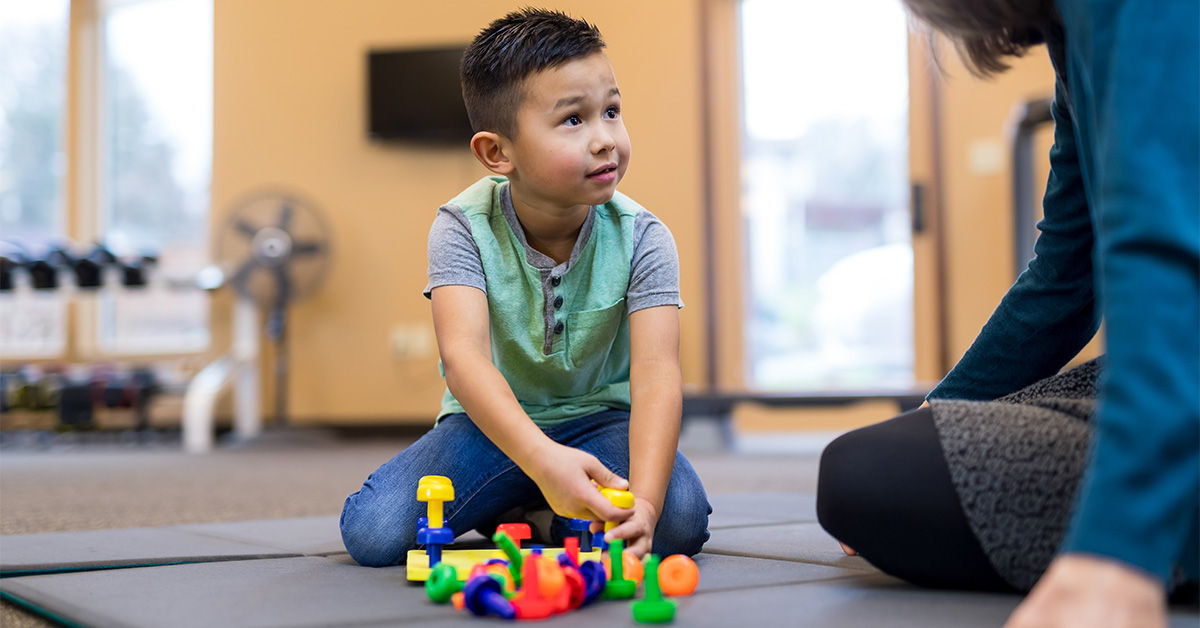Play Therapy
 Photo courtesy of Health lineOpens in new window
Photo courtesy of Health lineOpens in new window
Play therapy is a counseling approach that utilizes toys and play as the primary vehicle for communication. The rationale for this is that young children often lack the language or ability to verbally communicate what is going on with them. |
The Association for Play Therapy (APT)Opens in new window defines play therapy as “the systematic use of a theoretical model to establish an interpersonal process wherein trained play therapists use the therapeutic powers of play to help clients prevent or resolve psychosocial difficulties and achieve optimal growth and development” (Association for Play Therapy, n.d.).
Even older children and adolescents with well-developed verbal skills may benefit from play therapy since they may be better able to act out their issues or communicate their feelings through play rather than through traditional talk therapy.
Play therapy is considered especially appropriate for children between the ages of 3 and 12 years who have difficulty with verbal reasoning but may also be suitable for very young (1-1/2 to 2 years) or older (ages 11 – 15) children who have experienced trauma.
Play therapy may be appropriate for children who are experiencing behavioral or emotional difficulties, including (but not limited to) aggression or acting-out behavior, attachment difficultiesOpens in new window, attention-deficit hyperactivity disorderOpens in new window, conduct disordersOpens in new window, phobiasOpens in new window, separation anxietyOpens in new window, and selective mutismOpens in new window.
Play therapy may also be suitable for children who are contending with grief, adoption, divorce, abuse or neglect, hospitalization, chronic or terminal illness, or traumas such as war, natural disasters, kidnapping, or automobile accidents.
Play therapy approaches range on a continuum from nondirectiveOpens in new window (meaning the child rather than the therapist generally directs what transpires, as in child-centered play therapyOpens in new window) to directive (e.g., TheraplayOpens in new window, in which the therapist directs the course of therapy).
Approaches that combine both directive and nondirective elements include Adlerian and cognitive-behavioral play therapy. In play therapy, children choose from a variety of play materials, including toys, games, and art supplies, which they use to express themselves in the language of play.
Toys and play materials offered for therapy cover a range of developmental stages (toys for both younger and older children) and include family/nurturing toys, aggressive toys, scary toys, expressive toys, and pretend/fantasy toys (Kottman, 1999).
The play therapist works with a child’s family and/or teacher to formulate goals for the play therapy. Whenever possible, the child is included in the formulation of treatment goals.
Play therapy goals vary depending on the child’s issues and presenting problems as well as the child’s age and developmental stage. General play therapy treatment goals may include:
- Enhancing self-confidence and self-reliance
- Helping the child explore and express feelings
- Practicing self-control and self-responsibiltiy
- Developing problem-solving and relationship-building skills, and
- Exploring behavioral alternatives.
Basic play therapy techniques include:
- Tracking (describing the child’s behavior to the child)
- Restating the content (paraphrasing the child’s verbalizations)
- Reflecting the child’s feelings
- Returning responsibility (for behaviors or decisions) to the child, and
- Using the child’s metaphor (adopting the child’s story without imposing one’s own meaning or interpretation).
Setting appropriate limits with the child and maintaining a consistent structure for play therapy sessions can provide the child with a sense of predictability and self-control and provide a safe space for the child to explore and do therapeutic work.
Limits and structure include things such as leaving toys and play materials in the room, starting and stopping sessions on time, and agreements that the child not harm itself or others during the session.
Approaches to setting limits in play therapy include starting the limit in a nonjudgmental way, reflecting the child’s feelings, engaging the child in redirecting its own inappropriate behavior, and setting up logical consequences that the child can enforce (Kottman, 1999).
The APT emphasizes that the practice of play therapy by licensed or certified mental health professionals requires specialized training and supervised clinical experience.
- Associat for Play Therapy. (n.d.). About play therapy: Overview. Retrieved from http://www.a4pt.org/ps.playtherapy.cfm
- Kottman, T. (1999). Play therapy. In A. Vernon (Ed.), Counseling children and adolescents (2nd ed., pp. 98 – 119). Denver, CO: Love.

